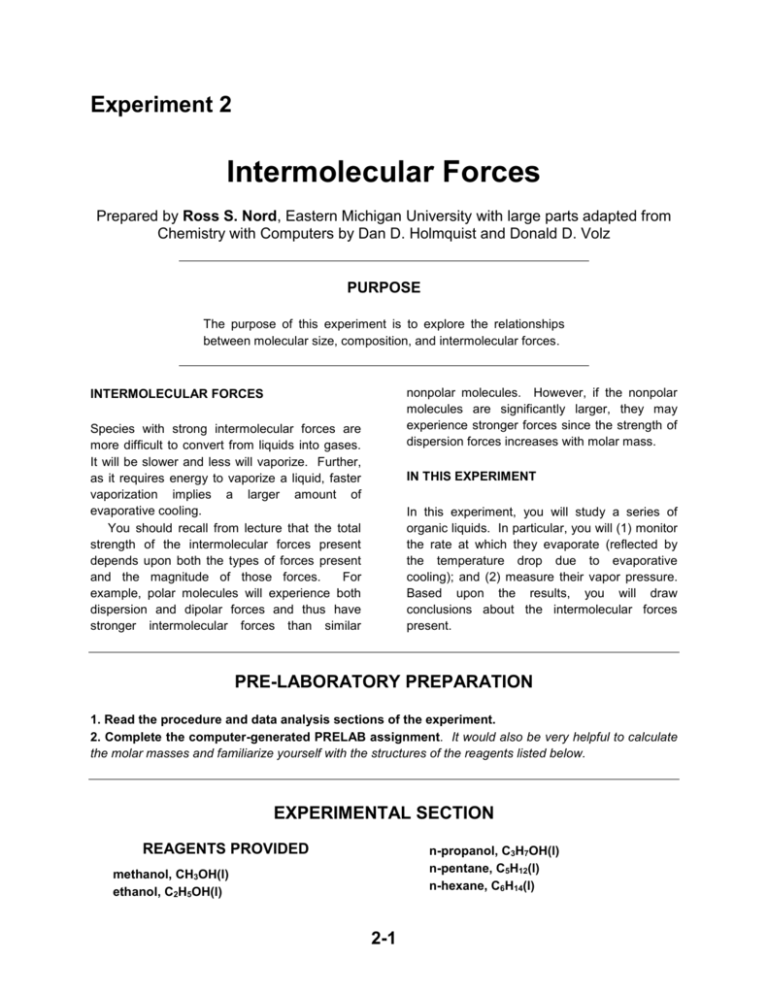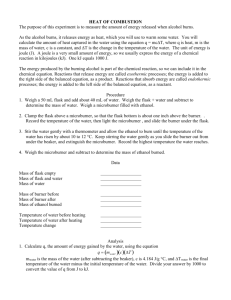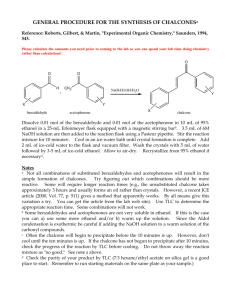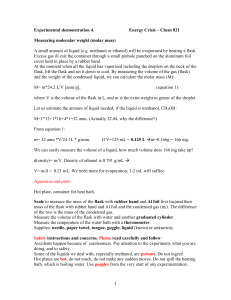Intermolecular Forces - Eastern Michigan University
advertisement

Experiment 2 Intermolecular Forces Prepared by Ross S. Nord, Eastern Michigan University with large parts adapted from Chemistry with Computers by Dan D. Holmquist and Donald D. Volz PURPOSE The purpose of this experiment is to explore the relationships between molecular size, composition, and intermolecular forces. nonpolar molecules. However, if the nonpolar molecules are significantly larger, they may experience stronger forces since the strength of dispersion forces increases with molar mass. INTERMOLECULAR FORCES Species with strong intermolecular forces are more difficult to convert from liquids into gases. It will be slower and less will vaporize. Further, as it requires energy to vaporize a liquid, faster vaporization implies a larger amount of evaporative cooling. You should recall from lecture that the total strength of the intermolecular forces present depends upon both the types of forces present and the magnitude of those forces. For example, polar molecules will experience both dispersion and dipolar forces and thus have stronger intermolecular forces than similar IN THIS EXPERIMENT In this experiment, you will study a series of organic liquids. In particular, you will (1) monitor the rate at which they evaporate (reflected by the temperature drop due to evaporative cooling); and (2) measure their vapor pressure. Based upon the results, you will draw conclusions about the intermolecular forces present. PRE-LABORATORY PREPARATION 1. Read the procedure and data analysis sections of the experiment. 2. Complete the computer-generated PRELAB assignment. It would also be very helpful to calculate the molar masses and familiarize yourself with the structures of the reagents listed below. EXPERIMENTAL SECTION REAGENTS PROVIDED n-propanol, C3H7OH(l) n-pentane, C5H12(l) n-hexane, C6H14(l) methanol, CH3OH(l) ethanol, C2H5OH(l) 2-1 Experiment 2 – Intermolecular Forces 3. Choose Experiment then Data Collection… and change the length from 180 to 600 seconds. Then click on Done. HAZARDOUS CHEMICALS All of the liquids are flammable – no open flames in the lab. Methanol is toxic. Pentane can be narcotic in high concentrations. Hexane can be irritating in the respiratory tract. 4. Clean 6 test tubes and fill the bottom 2 cm (approximately) of each tube with one of the following liquids: distilled water, methanol, ethanol, n-propanol, pentane, hexane. Either label your tubes, or be very careful to keep them in order in your test tube rack. WASTE DISPOSAL Pentane and hexane should be disposed of in waste containers in the hood. The remaining liquids can go down the drain. EVAPORATIVE STUDY 5. Wrap the bottom of each temperature probe with a square piece of filter paper. Secure them with small rubber bands. SPECIAL EQUIPMENT An interface should be attached to each of the computers in the lab. Two temperature probes and a gas-pressure probe should be provided. 6. Place one probe into the test tube of water and the other into the test tube of methanol. PROCEDURE 7. After 45 seconds (to allow the temperature to stabilize), record the initial (maximum) temperatures and click on Collect. This experiment could be done individually, but due to equipment limitations you will do the experiment with a partner (or two, if necessary). 8. After 5 seconds, remove the probes from the liquids and drape them over your buret stand so that they are suspended in air. Because data will be collected by computerinterfacing, YOU MUST WORK AT A STATION WITH ACCESS TO A COMPUTER. 9. Monitor the temperatures. After both temperatures have reached minimums and started to increase, click on stop. SETUP 10. Record the final (minimum) temperatures for each liquid on your data sheet. You do not need to save or print out the data. We collected it simply so it was easier to monitor when the minimum was reached. 1. Double-click on the LOGGER PRO icon from the desktop. If the interface box icon does not appear in the upper left, make sure the box is connected to the computer and has power, then restart Logger Pro. 11. Remove the filter paper from each probe (and discard in the wastebasket). Wipe off the probe with a paper towel. 2. Attach temperature probes to CH 1 and CH 2 of the interface box. Logger Pro should automatically recognize them and set them up for you. No calibration is necessary. 12. Repeat steps 5-11 for the four remaining liquids (two-at-a-time). Wipe off the temperature probes between trials and use fresh filter paper each time. 2-2 Experiment 2 – Intermolecular Forces 13. Dispose of the pentane and hexane in waste containers in the hood. The remaining liquids can go down the drain. 20. Securely fasten the 125-mL Erlenmeyer flask in the utility clamp. Raise the clamp so that the flask can be lowered into the water bath. Then lower the flask into the bath as far as possible and tighten the clamp. Allow at least two minutes for the air temperature in the flask to equilibrate with the water bath before attaching the syringe (step 22). However, you can proceed with step 21 and get the syringe ready, while waiting. VAPOR PRESSURE STUDY 14. Remove the temperature probe from CH 1 of the interface. Connect the pressure sensor to CH 1. Leave the other temperature probe connected to CH 2. The interface box should automatically recognize the pressure sensor. 21. Prepare a 10-mL syringe with 1 mL of ethanol. There will be a covered beaker of ethanol on the front bench. a. Push the syringe’s plunger all the way in. b. Place the end of the syringe in the ethanol. c. Pull back on the plunger to draw ethanol into the syringe until it reads 1 (±0.2) mL. d. Re-cover the beaker of ethanol. 15. Change the pressure units to mm Hg by double clicking on the Pressure column heading in the Data Table. Then click on the unit box and select mm Hg. We choose mm Hg simply because it is the unit most commonly used for vapor pressure. If the sensor is operating correctly, the pressure should be close to 760 mm Hg (although most days it is closer to 750). If it is not, your instructor needs to check your setup. 22. Attach the plastic syringe to the other fitting on the stopper, but do NOT inject the sample yet. The syringe can be attached by gently turning clockwise about half a turn. Check that the connections are tight as leaks will affect your results. 16. Take the three-hole rubber-stopper (with two plastic fittings) from the Gas Pressure sensor box and insert it firmly into a 125 mLErlenmeyer flask. Important: To ensure a tight fit, twist the stopper slightly as you are inserting it into the neck of the flask. Note that the necks on some flasks are too large for the stoppers. Exchange for one with a smaller neck, if needed. 23. Click on Collect, allow about 10-15 seconds for the reading to stabilize, and then record the air pressure and temperature inside the flask (on the lines for P1 and T1 on your data sheet). We are assuming the air temperature inside the flask is equal to the water bath temperature. If you wait too long, ethanol from the syringe will start vaporizing and the pressure will begin systematically drifting upward. 17. Connect the stopper to the gas-pressure sensor with the plastic hose provided. The stopper has two fittings on the top. The hose can be connected to either of the fittings. 18. Prepare a water bath containing hot tap water and put the temperature probe into it. Take a 600 mL beaker and fill it with about 400 to 450 mL of hot tap water. 24. Squirt the ethanol into the flask by pushing the plunger in all of the way. Do NOT remove the syringe. Drawing the plunger back to where it started would eliminate any bogus pressure variation due to the volume of the flask changing when the ethanol is added. 19. Obtain a utility clamp and loosely attach it to a buret stand (below the buret clamp). 2-3 Experiment 2 – Intermolecular Forces value, click stop and record the minimum pressure and the corresponding temperature on your data sheet (in the lines for T2 and Pfinal). Again it takes a few minutes for the reading to stabilize. You should observe that the pressure decreases as the temperature is lowered. However, given the crudeness of our apparatus, the relative error introduced is negligible. This injection may cause a spike in your pressure-temperature plot. If so, ignore this spike when looking for the peak pressure later. 25. Monitor the pressure reading. After the pressure has reached its peak value and starts to go back down, click stop and record the peak pressure and the corresponding temperature on your data sheet (in the lines for T2 and Pfinal). Pfinal is the pressure due to both the air and the vapor pressure of the injected ethanol. The pressure in the container should not be large enough to force the syringe plunger out. But, make sure it remains pushed in. It should reach its peak within a few minutes. The peak reading should be at least 70 mmHg greater than the initial reading. If not, you probably have a leak (probably the rubber stopper) and should try again. If you repeat, either use a different flask or clean yours thoroughly to remove the alcohol. While you are waiting, you could answer the questions for the Evaporative Study (and occasionally monitor the pressure). A good, efficient lab worker can multi-task. 30. Disassemble your apparatus. Dump out the excess ethanol (in the sink), rinse and dry the Erlenmeyer flask. Over a sink, pump the syringe several times to eject any residual ethanol out the end. When you open the flask, a little ethanol may spray out. Some ethanol will definitely be ejected when the syringe is pumped, so be sure the syringe is not pointing at anybody. 31. Reassemble the apparatus (steps 20 and 21), putting 1 mL of methanol in the syringe this time. 27. Remove the temperature probe from the hot water bath and move it into the cold bath. 32. Repeat steps 22-25 for methanol using a cold water bath. We are only collecting data for methanol using the cold water temperature water bath. As for the ethanol, it will take a few minutes for the methanol to totally saturate the vapor phase. Only wait a few minutes to take your reading (the maximum pressure), as for ethanol. Since the pressure will slowly increase as the bath temperature drifts up to room temperature, you would have to wait a very long time before the pressure actually starts to go down. 28. WITHOUT REMOVING THE SYRINGE OR DISLODGING THE STOPPER, raise the flask out of the hot water bath and lower it into the cold water bath. DISASSEMBLE THE EQUIPMENT AND RETURN THE PARTS TO THEIR CONTAINER. HAVE THE T.A. CHECK YOUR STATION BEFORE LEAVING THE LAB. 29. Click on Collect to begin collecting data. When the pressure reaches its minimum It's always a good idea to wash your hands before leaving the laboratory. 26. In a second 600-mL beaker, prepare a water bath with 400-450 mL of cold tap water. 2-4 Experiment 2 – Intermolecular Forces Name Station Used Partner Instructor/Day/Time Partner Station Checked & Approved DATA SHEET AND DATA ANALYSIS EVAPORATIVE STUDY Substance Maximum Temperature (C) Minimum Temperature (C) T Tmax - Tmin (C) Water Methanol Ethanol n-Propanol Pentane Hexane 1. In the hypothetical case of a liquid that had such strong intermolecular forces it would never evaporate, what temperature change would you expect to see? 2. Which of the three alcohols had the strongest intermolecular forces? Explain why this result makes sense (assuming it does) based upon the structure of the three molecules. 3. Would you expect the value of T for n-butanol, C4H9OH(l), to be larger or smaller than the value for n-propanol? 4. Given that the molar mass of n-butanol is very similar to that of pentane, which would have a larger value for T? Explain why, based upon the intermolecular forces present. 2-5 Experiment 2 – Intermolecular Forces VAPOR PRESSURE STUDY Substance Trial Ethanol Hot Water Methanol Cold Water Cold Water T1, Initial Air Temperature (C) P1, Initial Air Pressure at T1 (mmHg) T2, Final Temperature (C) Pfinal, Final Pressure (mmHg) P2, Air Pressure at T2 (mmHg) Pvap, Vapor Pressure (mmHg) 5. The final pressure in the flask, Pfinal, is a sum of the vapor pressure of the liquid, Pvap, and the air pressure exerted at the measured temperature, P2. Calculate P2 for each sample using Amonton’s Law and record it in the above table: 𝑷𝟏 𝑷𝟐 = 𝑻𝟏 𝑻𝟐 Use the same P1 and T1 for the cold water ethanol bath as for the hot water bath. Show a sample calculation for the ethanol hot water bath. Be sure to use kelvin (273 + C) for temperature. 6. Determine Pvap for each sample by subtracting P2 from the measured final pressure, Pfinal. 7. According to the Clausius-Clapeyron equation, where R is the gas constant (8.31 J/molK): 𝑷𝒗𝒂𝒑,𝒄 −𝑯𝒗𝒂𝒑 𝟏 𝟏 𝒍𝒏 ( )= ( )( − ) 𝑷𝒗𝒂𝒑,𝒉 𝑹 𝑻𝟐,𝒄 𝑻𝟐,𝒉 T2 is in kelvin, Pvap stands for vapor pressure, and c is for cold water and h is for hot water. Rearrange and solve for the enthalpy of vaporization, Hvap, of ethanol. Show your calculation: Hvap = ________________________ 8. Based upon the cold-water-bath-temperature vapor pressures, which liquid had the stronger intermolecular forces? Briefly explain why this result makes sense (assuming it does) based upon the structure of the two molecules. 2-6







